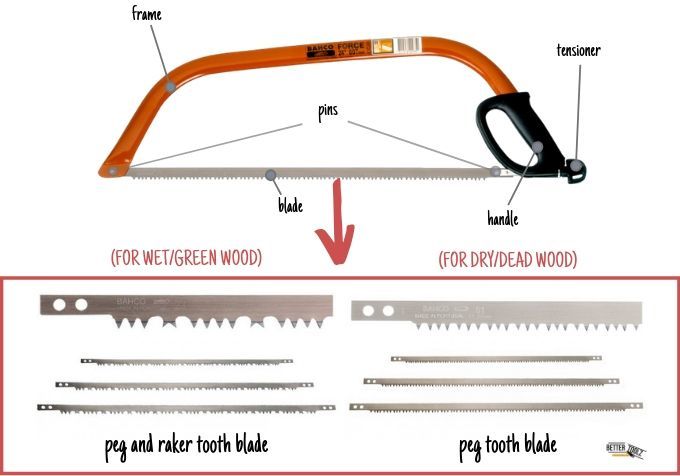
1. The Blade
The blade of your bow saw is long, thin, and straight. It can be removed from the frame so you can sharpen or replace it. The blade is used to cut through tree branches, shrubs, and even tree trunks, every part of a tree in fact!
Bow saws, unlike several other saws, have a cutting stroke which means they can cut on both the push and pull stroke. Their teeth are angled in different directions, which speeds up the cutting process. Bow saws have two types of blades: peg tooth blades and peg and raker tooth blades.
Peg Tooth Blades: The peg tooth blades have triangular teeth that are grouped in sets of three and each tooth has a large gap between it and its adjacent tooth.
There are typically 6 to 8 teeth per inch on a majority of bow saw blades and the two types of blades are made for cutting either a live or dead tree.Peg tooth blades are designed to cut dry and hard wood, which is usually a dead tree that has been down for some time.
Peg and Raker Tooth Blades: Raker tooth blades cut just the opposite, cutting through wet wood or green wood which typically refers to an alive tree that is still growing in the ground.
This blade's teeth are grouped in sets of four triangular teeth with a "raker" tooth following. The raker tooth is half the size of a regular tooth and is angled outwards, oftentimes having around 4 to 6 teeth per inch.
The peg and raker tooth blade's triangular teeth cut through the wood and the "rakers" chip the wood out. A larger and deeper groove is found in the peg and tooth raker type blade, so it can remove the chippings from the cut easily.
2. The Handle
The handle of your bow saw is known as a closed pistol grip handle. To use it, stick your hand in the closed space and curl your fingers around the handle. The closed handle will protect your hand from slipping out or getting injured if you hit something suddenly.
The handle of your bow saw is usually found on saws that have bigger and longer blades. These blades are great for quickly getting firewood ready to go on the flame.
3. The Frame (or Bow)
Your bow saw has a large hollow metal frame like that of an archer's bow. This saw, especially when sharpened, is dangerous. Most models have a very similar shape but you can find slight variations to the frame if you look at different manufacturers.
Some models even have a second hand grip located along the top of the frame, at the opposite end that the primary handle is located.
4. The Pins
To hold the blade in place, there are two pins on both ends of the frame. These pins hook into two holes on both ends of the blade. When these pins are hooked in properly, you can begin putting tension on the blade.
The pins closest to the handle of your bow saw are known as "rear blade mounting," while the pins near the top of your bow's frame are known as "front blade mounting."
5. The Wing Nut
Also known as the turnbuckle or tensioning mechanism, the wingnut is the piece you use to loosen and tighten the blade on your bow saw.
When you are removing or putting on a blade, the first thing you will want to move is the wingnut. It controls a bar beneath the handle, which is attached to one end of the blade. Turning the wingnut counter-clockwise pushes the bar forward and loosens the blade in the frame.
Other models may not have a wingnut or a closed pistol grip handle but rather a tensioning mechanism that looks like a crank or something similar.
When removing the blade, it's highly recommended to remove the side closest to the handle first. When installing the blade, it should be tightened enough where it does not move on the pins (but can bend a little in the middle). Too loose and your blade could fall out; too tight and it could snap, possibly causing injury.

